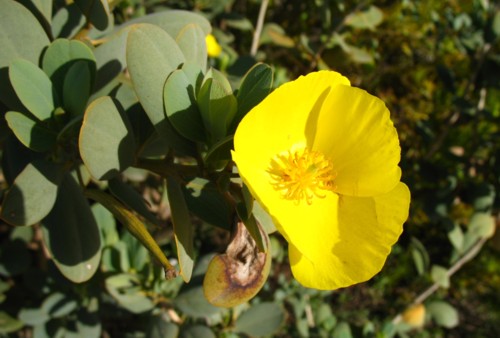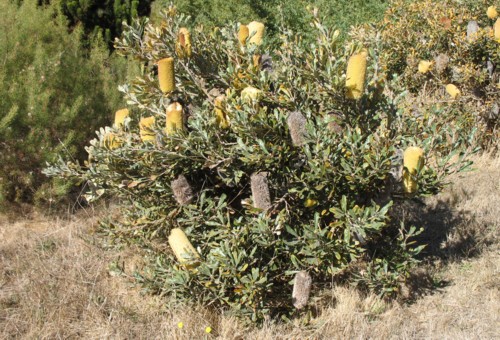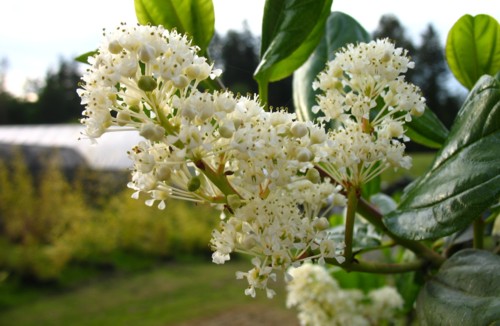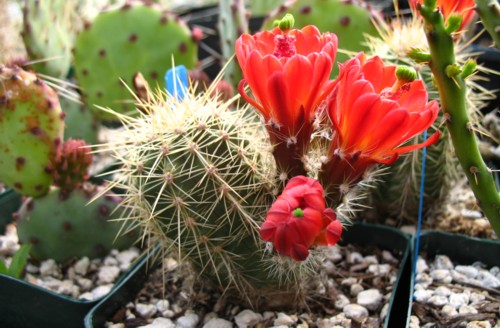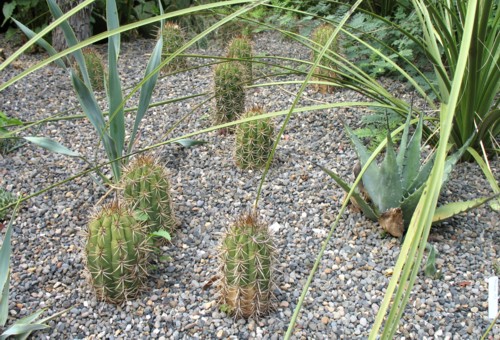|
2007 Plant Photo of the Month Archive
|

Plants and Gardens Gallery |
|
In this splendid example of desert plants being used in a parking strip between the sidewalk and the road, Agave parryi is combined with other cacti and succulents in a well drained raised bed. These were salvaged from an established garden in suburban Pierce County, where they grew for many years but were no longer desired by the owner. Some of the other plants visible in the photo are Hesperaloe funifera, Aloe ecklonis, Trachycarpus fortunei and a Puya species. Photo at Jungle Fever Exotics, Tacoma, Washington, December 2006. |
|
|
Although not the hardiest of Grevilleas, Grevillea alpina 'East Grampians' has grown well in my garden for several years now, even on heavy clay soil. It seems to be hardy to temperatures at least in the teens as long as it isn't pampered too much. Every year it produces multi-colored yellow and red flowers over a long period, some years peaking in January, other years in February. Grevilleas provide some of the best winter flowers of any garden plants for the Pacific Northwest. |
|
|
The showy flowers of a Bomarea species at UC Berkeley Botanic Gardens, California. Bomarea is a genus of vining, perennial plants with very nice flowers that are attractive both from a distance and up close as seen here. Related to Alstroemeria, they form tuberous roots from which they can regenerate after injury or dormancy. They originate in Mexico and South America, frequently at high altitudes where temperatures are cool and precipitation is high. I saw one as high as 12,000' altitude in Peru! Not surprisingly, they are quite at home in the equable climate of the immediate west coast of the United States; appreciating rich, moist soil and lots of water in the garden. They remain rather rare in cultivation, especially in the Pacific Northwest where not a lot is known about their cold-hardiness. I kept B. hirtella in my garden for several years before it fizzled out. But with a little care and mulch to keep the soil from freezing, some species might make excellent garden plants for our region, especially B. salsilla which comes from the more seasonal climate of Chile. Their taxonomy is not too well known to me: I couldn't tell you what species that is in the picture. |
|
|
This sunny yellow flower belongs to Dendromecon harfordii. Photographed here at the UCSC Arboretum, this large tree-like shrub (common name 'tree poppy,' appropriately) is one of approximately 65 plant species endemic to the Channel Islands off California's southern coast. I have one in a pot and I am debating where to put it. I have been warned that it likes to be very dry. Well, if I plant it in Poulsbo, where it is indeed very dry, it may freeze: Although it's tough enough for much of California, I'm expecting trouble below about 20°F in this climate. I'm not sure what I will do with it, but I'd better figure something out quick! |
|
|
Another photo from the highly esteemed UCSC Arboretum, this one of a Banksia species. Most of them seem a little less hardy to cold than the hardiest Grevilleas, but it's possible some of them may have a chance here. I have raised a few plants of B. canei, the mountain Banksia, which is probably the hardiest species. This year I discovered that many Banksia species can also be propagated from cuttings quite easily. As of this writing I offer two species, but look for many more in the future. The plant pictured, in it full glory in October, was an unlabeled species. |
|
|
Ceanothus velutinus var. hookeri is one of the larger broadleaf evergreen shrubs native to the Pacific Northwest. Although it has attractive glossy leaves and showy white spring flowers, it is not commonly cultivated. Reasons for this include challenges with propagation (it is not really that easy from cuttings or seed) and its preference for very dry soils - like manzanita, it is not a plant for irrigated gardens. Also, it tends to have a rather wild-looking, rangy habit. I think that it has excellent potential for hybridization with other Ceanothus - the very large leaves and flowers are attractive. The variety hookeri, found west of the Cascades in Washington and British Columbia, may exceed 15' tall in the wild. The variety velutinus, which occurs frequently on the east slopes of the Cascades and throughout the interior high country of the Northwest, is a lower-growing, rounded shrub. It too should be hybridised with other Ceanothus since it is extremely cold hardy. I obtained the plant pictured by digging a 7' tall volunteer seedling that a gardener on Bainbridge Island didn't want. Usually they don't survive that experience, but I pruned it back and gave it some time to reroot into some bark before replanting it. |
|
|
This Echinocereus species has turned out to be one of my more spectacular mail order purchases. It comes originally from the vicinity of the Gila Cliff Dwellings north of Silver City, New Mexico, where it is found on gravelly north and east facing slopes. As this is a very cold and somewhat wet area (it is mostly forested) and the plants are often covered with snow in winter, I don't doubt that this showy little cactus will have no trouble adjusting to our climate once planted out. In fact, it already lived through 15°F last winter in my unheated greenhouse with no problems. |
|
|
Here's an interesting section of the desert garden at Cistus Nursery in Suavie Island, Oregon (a place where I generally like what they do). Where a few cacti and Agaves froze out, melted in the rain or were moved, a sapling Trichocereus forest has been installed. These look like probably T. terscheckii but they could be another species. The columnar Trichocereus mostly come from Chile, northwestern Argentina, Bolivia and southern Peru. Many species from Argentina are exciting garden plants as they grow in cold and frosty areas, and are not difficult to grow, being surprisingly tolerant of moisture. T. tercheckii and T. pasacana can grow 30' tall or more and are treelike in stature - resembling our own Southwestern native giant suguaro (Carnegeia gigantea) but much faster and easier to grow outside of its native habitat. Could it be that this giant will prove viable in certain parts of the Pacific Northwest? There's only one way to find out! We should all try it, and hopefully it will be among many exciting future offerings at The Desert Northwest. |
|
|
|
|
|
|
|
|
|
|
|
|
|



